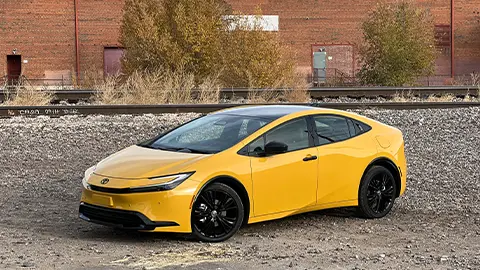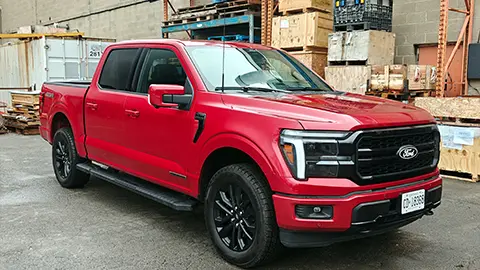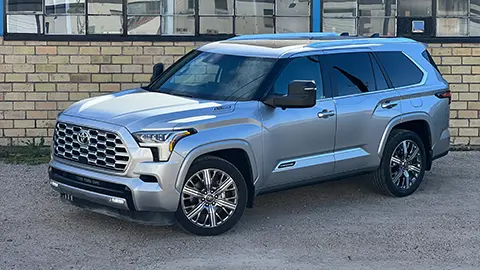First Fully Electric Honda SUV
When it launched in dealers across the U.S. this April, the Honda Prologue became the first mass-produced electric vehicle from the world’s largest builder of internal-combustion engines. Honda’s engines power everything from lawnmowers to motorcycles to cars and SUVs and even airplanes. While it has built, in limited numbers, hydrogen fuel-cell vehicles in the past, and has sold millions of hybrids globally, the Prologue is a big step for Honda – into a highly competitive arena.
Our initial impressions from the launch in April were good: the Prologue drove well, had good software, and a strong value proposition to go with decent range and performance. Buyers, too, seem to be finding a lot to like: from sales of just over 600 cars in May 2024, its first full month on the market, Honda moved almost 3,500 Prologues in June, a massive growth curve. The Prologue now represents over 3 percent of Honda’s total sales – not bad for a single electric model in a gas-dominated lineup.
Curious to see what the Prologue was like to live with on a more extended basis, we spent a week behind the wheel of a 2025 all-wheel drive model.
Honda Prologue Driving Impressions
First impressions are that the Prologue doesn’t feel particularly like a Honda to drive. But, after a couple of minutes, you realize that’s because the way Hondas drive, up until now, has been defined by Honda engines – the sounds they make, the unique way VTEC and turbocharging deliver power, and even the way the starter motor sounds. As an electric vehicle, the Prologue has none of that: it simply has a lot of power, delivered completely silently and completely effortlessly, with no gear shifts and no fuss.
Unlike many other electric vehicles, which have almost overwhelming amounts of power to shock potential buyers with their speed, the Prologue has an entirely reasonable amount of go for its purpose. All-wheel drive models, like the one I drove, have 288 hp and 333 lb-ft of torque – more than enough to provide brisk acceleration at any speed, as well as efficient cruising, but not enough to snap your neck back. The upside of this reasonable power output is excellent efficiency: in mixed city and highway driving, I averaged well over 3.2 miles per kilowatt-hour (mpkWh), which is very good for a vehicle this large.
With an 85-kWh battery, the EPA estimates the range of the Prologue to be 296 miles for the 212-hp front-wheel drive model, and 281 miles of estimated range for all-wheel drive models. My real-world experience showed that these numbers were conservative, and the more city driving you do, the better your range gets. The Prologue’s brake regeneration seems particularly well-calibrated, and uses sensors in the front of the car to claw back a bit of energy in traffic, as well as when using the brake pedal. There is also a handy paddle you can pull on the steering wheel to manually activate stronger regeneration; or you can choose an aggressive one-pedal driving mode.
Lack of engine character aside, there is a lot to like about the Prologue. Despite its long wheelbase, it has a very tight turning circle, making it easy to maneuver in town and in tight parking lots. The steering has a nice weight to it, and is very accurate, if maybe a little slower than you might expect. Brake pedal feel is excellent – smooth and progressive with an imperceptible transition between regen and the use of the physical brakes. The big Prologue rides incredibly smoothly even over rough pavement, and it goes around corners well, too, without a lot of body roll, and with a high level of confidence.
Shared GM Parts in the Honda Prologue
As you have probably read, the Prologue is built on a shared architecture with General Motors, leveraging that company’s Ulitum technology for its battery, electric motors, and power electronics. This brings the Prologue a lot of advantages, including impressive efficiency, fairly rapid charging speeds, and a choice of front- or all-wheel drive. Building the Prologue off GM’s componentry also means that Honda was able to get it to market faster, while it completes development of its own electric architecture, due in 2027.
This is not the first time that Honda and General Motors have worked together on an SUV. In the 1990s, the two companies created the Passport, a midsized truck based on the Isuzu Rodeo (there was also the Acura SLX, which was a re-badged Isuzu Trooper). In the early 2000s, the now-defunct Saturn brand used Honda V6 engines and transmissions in its popular Saturn Vue SUV.
Prologue Exterior and Interior Design
To its credit, the Prologue goes a lot further than any of these vehicles in terms of having its own identity. While it shares its gorgeous long-wheelbase, low-roof proportions with the Chevy Blazer and Cadillac Lyriq (as well as the high-priced Acura ZDX), the Prologue has its own distinctive look: with slim rectangular headlights, large wheels, gloss-black accents, it is clean, simple, and recognizably Honda. (I really liked the retro-style Honda lettering on the rear end, which will be used on all electric Honda models, as well.)
Prologue’s interior is equally distinctive in terms of its design. It shares very little with the Blazer, whose interior is dominated by a big curved panel integrating dual screens and giant circular air vents. The Honda is much more restrained in its design, and more calming to be in: the dashboard is low-set, with a strong horizontal emphasis and slim air vents and climate controls and separate digital instrument cluster and infotainment displays. There’s a large open storage tray set above an even larger open storage area in the console, as well as a large bin underneath the center armrest, and large cupholders.
Because of its dedicated EV platform – the Prologue was never designed to have an engine – Honda and GM have maximized interior space with a short hood and an extra-long wheelbase. Despite the tight rear overhang, there’s tons of cargo room in the back (no three-row option is available) and the rear seats are positively luxurious, with tons of room to stretch out. As you would expect, the seats fold flat easily to expand the cargo area, providing additional versatility.
While the Prologue’s interior looks like a Honda’s would, down to its circular, aluminum-effect climate knobs, upon closer examination, it doesn’t have quite the same level of solidity and build quality as you’d find in a Pilot or a CR-V. While the synthetic leather upholstery is nice – you have a good choice of colors, which even offer luxurious contrast stitching – the rest of the interior doesn’t quite live up to the Prologue’s $47,400 starting MSRP (before destination). The plastics on the dash, door panels, and console are hard and scratchy; what looks like metal trim is plastic; and the seats are hard and a little flat.
Tech Includes Apple CarPlay
If you’ve spent your life driving Hondas, some of the Prologue’s controls will take some getting used to. For instance, instead of separate stalks for lights and wipers, there’s a single column stalk to the left that controls both. The gear selector is a stalk to the right of the steering wheel instead of the usual lever. The hazard light switch is, inexplicably, up above, in a console on the roof. Other controls, such as the large, physical knobs and buttons for the climate, and the touchscreen, are very easy to use and require no adaptation at all. It’s worth noting that, while GM has decided not to offer Android Auto or Apple CarPlay in its vehicles, including the Blazer EV, they are both standard in the Prologue, along with a nifty wireless charger that holds your phone upright in the console.
Like its GM platform siblings, the Prologue offers rapid Level 2 charging, at up to 11 kW on a compatible charger, which is 50 percent faster than many EVs in this class will charge when plugged in at home or work. Its 150-kW Level 3 fast charging speed isn’t class-leading, but you’ll still be able to get from 10 to 80 percent in less than half an hour, taking the sting out of road trips. The Prologue’s navigation system is Google-based, and its route planner will find the fastest, most convenient charging stops to save you time on your route. Like the rest of the infotainment system, it is lightning-fast and easy to use.
Prologue also comes with a full suite of useful driver-assistance features, including front and rear cameras that make parking a cinch; blind-spot monitors; lane-keeping assist; active cruise control; automatic emergency braking, and more. I found the lane-keeping assistant to be a little intrusive, and turned it off, but kept the lane departure warning system turned on.
Honda Prologue: Conclusion
The Prologue enters somewhat unchartered territory for Honda. The company’s first fully-electric mass-production vehicle for North America is also entering a fiercely competitive segment, where it’s up against spacious SUVs that pack gasoline, hybrid, and all-electric powertrains. Vehicles like the Toyota Highlander Hybrid, Hyundai Santa Fe, the related Chevy Blazer EV, and the Jeep Grand Cherokee plug-in hybrid all offer different mixes of styling, performance, efficiency, and tech – all for different kinds of buyers.
What the Prologue has going for it are distinctive, very Honda looks; a cutting-edge, highly-efficient drivetrain; a remarkably spacious interior for its footprint; and easy-to-use tech. It is also well-priced, particularly when you consider that it is eligible for the $7,500 federal tax rebate. Running costs will be low, as well, especially if you charge at home during off-peak hours, where a full “tank” of electrons will cost a small fraction of what you’d pay for gasoline.
While the Prologue might not feel quite like a Honda, thanks to its lack of an engine, and because of some of its GM ancestry, it is undoubtedly a strong product, and a very strong value proposition.
















